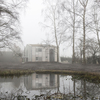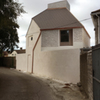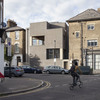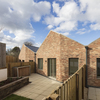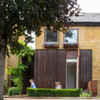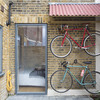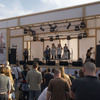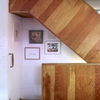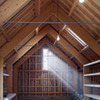Oak Lane House
Subscribe now to instantly view this image
Subscribe to the Architects’ Journal (AJ) for instant access to the AJ Buildings Library, an online database of nearly 2,000 exemplar buildings in photographs, plans, elevations and details.
Already a subscriber? Sign in
The ground-floor façade is clad in hand-laid knapped flints
Kilian O'Sullivan Download Original
At Oak Lane House Cassion Castle has taken advantage of planning changes to create a Californian house with Fenland characteristics.
The house is legible as a double layer of volumes. The ground-floor façade is clad in hand-laid knapped flints, laid over 100mm-thick, medium-density blockwork walls. The first floor façade is clad in 144mm strips of European larch, painted black. These two layers have been broken down into smaller volumes and in places pulled out of direct alignment.
Passing towards the kitchen, the glazing on the southern side of the sitting room and on the eastern side of the kitchen can be withdrawn fully and recessed in either wall. Thanks to a long truss there is no column, so the whole of the centre of the house facing the sun is potentially open. Off this room, which acts as the hearth of the building, there are more living spaces, guest bedrooms and offices, which are more private.
On the upper floor in particular the windows are addressed to the corners, rather than the centre: it is an approach that is enhanced by the way in which recessed grey steel finishes mark the junction of the flint-clad walls. Windows on the first floor are floor-to-ceiling and can slide to fully recess into pockets behind the timber cladding.
In order to achieve the apparently simple aesthetic of black timber boxes shifting forwards and backwards on top a flint base, a strict datum line running around the entire building was established with the detailing of a range of PPC aluminium cappings. Imagined as a subtle, simple line dividing the two floors of the house, the capping detail varies, depending on whether the timber sits directly above the flint, cantilevers past the line of the flint, or whether the flint projects past the timber, leaving a single-storey flint box.
Data
- Begun: Mar 2014
- Completed: Mar 2015
- Floor area: 450m2
- Sector: Residential
- Total cost: £1.4M
- Procurement: JCT Intermediate Building Contract with contractor’s design (ICD05)
- CO2 Emissions: 5.05kg/m2/year
- Address: Suffolk, IP30 9LD, United Kingdom
Professional Team 
- Architect: Cassion Castle Architects
- Project architect: Lee Pinchback
- Client: Rachel and Matthew Castle
- Structural engineer: Structure Workshop
- M&E consultant: Dragon Contracts
- Approved building inspector : MLM Building Control
- Project manager: Cassion Castle Architects
- Main contractor: Blackburns Construction (now merged with RG Carter Ipswich)
- CAD software used: Vectorworks
Suppliers
- Single-ply membrane finish to flat roofs: Polisystem UK
- Wood stain: Sadolin Classic
- Floor springs: Sadolin Classic
- Aluminium windows: Olsen Windows
- Frame ties: Ancoc Stafix




















